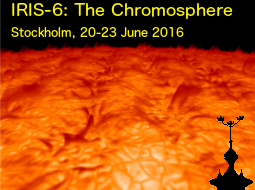Speaker
Eugene Avrett
(Smithsonian Astrophysical Observatory)
Description
A non-LTE semi-empirical model in which the calculated profiles of the C I, C II, O
I, O IV, Mg II, Si II, Si IV, and S I lines are compared with the IRIS observations
of an M1.1 flare reported by Tian et al.(2016). The temperature distribution, from
the low chromosphere into the transition region, is obtained by trial and error to
obtain reasonable agreement with profiles observed at flare maximum. The model is
1-dimensional, time- independent, in hydrostatic equilibrium, and includes He I and
He II which are found to be important. Ambipolar diffusion is included in modeling
the transition region. The O I atom consists of 20 levels, with partial frequency
redistribution in the 1305 and 1041 A multiplets, and with the effect of radiation
from the hydrogen 1026 A Lyman beta line (Bowen florescence). The hydrogen Lyman
alpha and Lyman beta lines are calculated with partial redistribution. The Mg II
atom has 9 levels and includes the h and k lines, with partial redistribution, and
includes the blend of subordinate lines at 2796 A. The C I, C II, O IV, Si II, Si IV
and S I have 19, 15, 20, 12, 18, and XX levels, respectively. We carry out non-LTE
calculations for H, He I, He II, C I-IV, O I-VI, N I-IV, Ne I-VIII, Na I-II, Mg
I-III, Al I-II, Si I-IV, S I-IV, Ca I-II, and Fe I-III The flare chromospheric
temperatures are much greater than in the quiet Sun, and the increase relative to
the quiet Sun extends to the temperature minumum region.
Author
Eugene Avrett
(Smithsonian Astrophysical Observatory)

